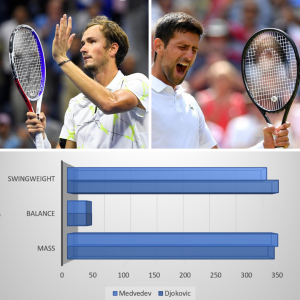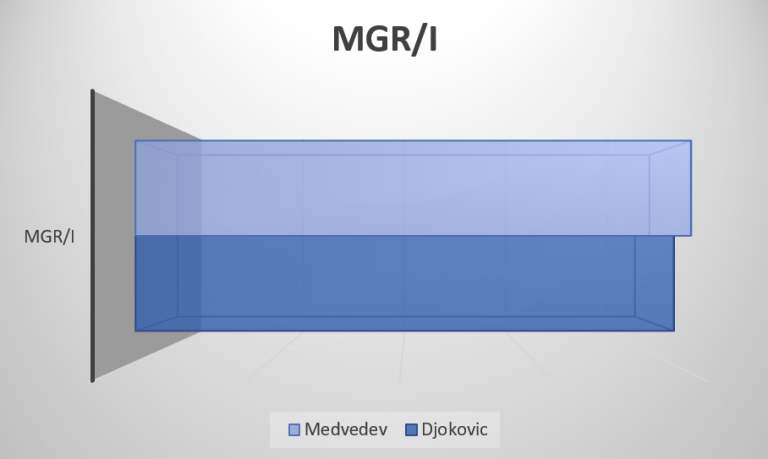
Introduction: The Technical Underpinnings of a Rematch
Welcome back to another deep-dive at Impacting Tennis, the platform where tennis isn’t just a game; it’s a physical and mechanical analysis. As we anticipate another Grand Slam showdown between Daniil Medvedev and Novak Djokovic, it’s critical to reevaluate their tactical arsenals and technical shifts since their last US Open final.
Mechanical Efficiency: Revisiting the Medvedev Setup (not much changed since 2021)
Back in 2021, Medvedev’s racket setup, characterized by a high MGR/I and an effective mass, provided him with the mechanical leverage to keep the ball deep and conserve energy in neutral rallies. While there is no definitive data that I could find for what Medvedev uses, I can make a pretty good estimate based on what is available. There is data from someone who owns his old rackets – Wilson Six-One (352 g) and Technifibre Dynacore 305 (35 – 359 g). Daniil used to use the Wilson Six-One racket, which is a heavy and head light racket with a medium swingweight, so it’s safe to assume that this translated to a similar setup when he switched to Technifibre. I remember seeing a picture from his customizer a couple of years ago, that he has some weight at the top of the handle under the grip. This would make the racket less polarized and create higher MGR/I (to mimic the Six-One). Based on his stroke mechanics, my best guess would be a set-up along the lines of 356-369 g, 32 cm balance and around 340 swingweight.
The Role of MGR/I in Medvedev’s Game
A higher MGR/I, as seen in Medvedev’s racket, results in a more stable swing and a reduction in torque at the hand. This mechanical property is critical in Medvedev’s gameplay for two reasons:
It provides him with increased control, crucial for landing shots deep in the court.
It leads to a reduction in muscular effort during strokes, thus conserving energy, an essential factor, especially when games go to 5 sets.
The 2023 Aggressive Turn
Medvedev has evolved his strategy to include a more aggressive playstyle while retaining the inherent benefits of his racket setup. The interplay of mechanical efficiency and tactical aggression poses a significant challenge for Djokovic, who has historically found it difficult to penetrate Medvedev’s defenses.

Djokovic’s Ascendance: Muscularity and Mechanics
Djokovic’s racket specs are similar to Medvedev’s but with slight differences that allows for increased spin and better shot angles. The relatively head-light balance and higher swingweight enables Djokovic to exercise a broader range of offensive strategies, albeit at the expense of more energy. A higher swingweight and lower MGR/I in Djokovic’s setup allow him to impart greater angular velocity to the ball, translating to higher topspin. This capability is critical when constructing points that can stretch Medvedev laterally along the baseline, disrupting his rhythm.
Physical Transformation in 2023: The Added Variable
Djokovic’s apparent recent increase in muscle mass adds another layer to this complex system. The increased muscle power potentially allows for a higher impact force, enabling Djokovic to overcome the traditionally challenging deep balls from Medvedev and try to not get caught up in long rallies, but Medvedev might also be looking to take control early as mentioned.
Psychological and Physical Pressure Equilibrium
Both players face different kinds of pressures. Djokovic is now free from the weight of achieving a Calendar Grand Slam like in 2021, but still faces expectations as he looks to extend the total grand slam lead. Medvedev, bolstered by past success and an aggressive stance, carries the weight of consistent performance and becoming a 2 times grand slam champion.
Anticipated Dynamics: Energy Expenditure and Tactical Evolution
Medvedev’s mechanically efficient setup and Djokovic’s improved muscle power pose a balance of strategy and endurance. Aggressive plays are energy-intensive, and in a five-setter, the fatigue factor could be the ultimate determinant. Medvedev’s game, rooted in mechanical efficiency, may offer an edge if the game stretches into an endurance battle. But if Djokovic is able to stay close to the baseline and keep the points short and intense and dictate the play, Medvedev might do more running and thus also expend more energy.

Conclusion: The Nexus of Mechanical Interactions and Athletic Prowess
The 2023 US Open final will be more than just a battle of skill. Both players’ rackets aren’t merely tools but extensions of their strategic inclinations and physical capabilities.
As always, this analysis provides just a piece of the complex puzzle that is professional tennis. The match is sure to be a spectacle, but keep an eye on how these nuanced technical aspects could tip the balance in favor of one of these tennis titans.
For more in-depth information on racket specifications of tour players, don’t forget to check our extensive database.